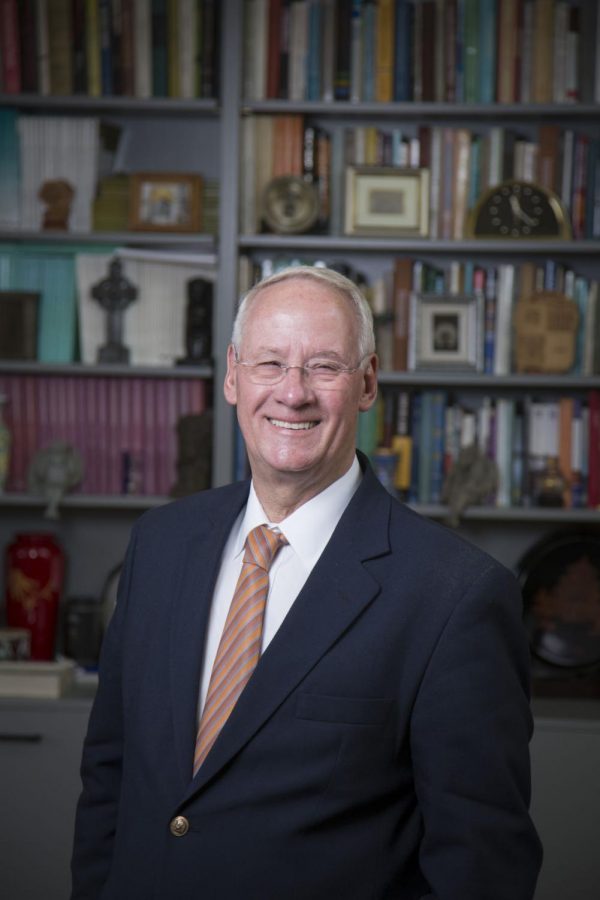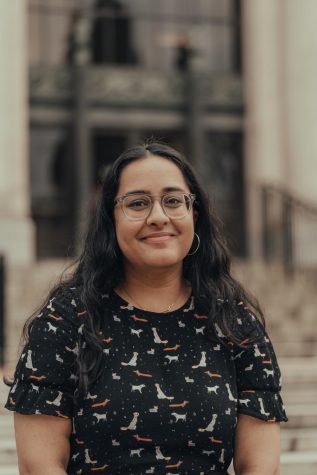President Emeritus Ray reflects on legacy left behind, looks to the future
July 26, 2020
President Emeritus and future professor of economics Ed Ray stepped down as president on June 30 after serving Oregon State University for 17 years, and recently reflected on the legacy he left behind.
“Five years ago, at age 70, I agreed to a new five-year contract as president at OSU. I will be 76 years old in just over two months and I decided that part of my job as president was to help with the transition to a new president while I remain healthy and effective at my job. No one is indispensable and I wanted to do what is best for the university and those we serve,” Ray said in an email.
F. King Alexander assumed the role of OSU president on July 1. When reflecting on his last year as president, Ray said every year is different and no one can predict the future.
“I did all that I could to make the transition to the new president as seamless and undramatic as possible. Clearly, no one predicted COVID-19, and, while the transition has gone smoothly, I failed on the dramatic front. On the other hand, F. King Alexander is an excellent choice to lead OSU. He believes in the land grant mission and he is passionate about advancing equity, inclusion and social justice and focusing on student success as among his top priorities. The university also has the best leadership team in place now that I have worked with in my 17 years here at OSU. We have a great team to deal with whatever comes our way,” Ray said.
In Ray’s last all-student email as president on June 30, he confirmed OSU’s support of the Black Lives Matter movement and efforts to end systematic inequality. In order for OSU to better serve Black students—who make up roughly 1% of students at OSU—Ray said the university needs to listen to student needs and address them on campus.
“We need to reach out to the community colleges, high schools and middle schools in Oregon and elsewhere to more effectively increase the presence of Black students and students of color at OSU. We also need to do a better job of providing financial support for Black students, students of color, PELL-eligible students, first generation and urban and rural students,” Ray said.
According to Ray, OSU’s graduates are the most important contribution to the future.
“We must raise our first-year retention rate for all groups of students from 85.3% to 90% and our six-year graduation rate for all groups of students from 67% to 70% as soon as possible and then set higher goals. We will succeed if we continue to build an inclusive community in which everyone is appreciated and valued,” Ray said.
Ray added OSU has impressive research programs in areas such as ocean studies, forestry, robotics, nuclear engineering, agricultural science and elsewhere that the university can build on going forward. Among other areas, Ray said he expects OSU to be a strong contributor to advances in addressing the problems of climate change, renewable energy and public health needs in Oregon, the nation and the world.
Ray said he believes Alexander will double down on increasing diversity among the faculty, staff and students, increasing first-year retention and six-year graduation rates for all students and eliminating achievement gaps.
“He will lead the second university-wide fundraising campaign for the university and focus on facility renovations, particularly for research facilities. He will redouble our efforts to deal with our carbon footprint and contribute to research on carbon fuel use reduction and carbon sequestration. President Alexander will lead us to the creation of a public safety program that protects and supports every member of our community and rejects the command and control approach used by too many police programs. He will champion programs at the OSU Cascades campus, the Marine Sciences program in Newport [Ore.] and service efforts through the state-wide public services, our Portland office and our Ecampus program. I am sure he has ideas for collaboration with other universities, community colleges and K-12 school systems throughout the state,” Ray said.
Provost and Executive Vice President Edward Feser said he believes Alexander will continue OSU’s focus on student success, access and inclusion, continued expansion of the research enterprise, and service to Oregon, given OSU’s land grant mission. Feser expects Alexander will put a lot of emphasis on continuing to build support in Salem and Washington, Ore. for the sustained and stable investment in public universities and the students who attend them.
In regards to working with Ed Ray, Feser said, “It was a pleasure. He is deeply committed to students and faculty excellence, respected shared governance, understood the primacy of the academic mission, and led with character and integrity. I enjoyed his candid and direct style, as I’m action-oriented and it helped facilitate getting things done more quickly than is the norm in higher education institutions. Inertia was not an option with President Ray.”
In broad terms, Feser said Ray helped OSU—including its faculty, staff, students and alumni—think bigger about what it could achieve in teaching, research and service.
“The renovation and expansion of many of our facilities, the historic fundraising campaign, the attention to student success, and the focus on diversity and inclusion are all well-known and important achievements. And there are others. But I believe his most lasting impact is helping this university believe it can accomplish much more if it aimed high, came together as a community, made big plans and executed them well. OSU is a far better university because of his leadership and the work of many others over 17 years who followed his lead,” Feser said.
Vice President and Chief Diversity Officer Charlene Alexander said during her on-campus interview, she left her meeting with Ed Ray convinced she wanted to work for this president.
“It’s rare to find a university leader so aware of his place in society and his responsibility to improve the lives of those less fortunate. Ed Ray has a passion for all students, faculty and staff but especially the students at Oregon State University campuses. He enjoys learning from and with students. He wanted to understand what works and what does not work; and when he hears about problems he instructs his senior staff to address those swiftly,” Alexander said.
When reflecting on some of Ray’s most notable achievements, Alexander highlighted the creation of the Office of Institutional Diversity following the student speak out in 2015 and the renovation of cultural centers on campus were major accomplishments. Additionally, Alexander said the first capital campaign raised significant contributions to support students and faculty research and provides on-going support for students in need.
In his spare time, Ray said he is “raising an apricot-colored standard poodle named Charlemagne, also known as Chuck. He is five months old and weighs [over 40] pounds.”
For Ray, his favorite part of being president was spending time with students. Ray said he will fortunately remain at the university as a professor of economics and plans to teach courses and take advantage of other opportunities to interact with students.
“I am interested in developing a couple of courses: one dealing with leadership and the other dealing with examining the changes we have seen in the way the global economy has worked since 2000, which is very different from traditional macroeconomic theory. If I can make progress toward figuring that out, I will share what I learn with students,” Ray said.

























































































































